Hansi Flick’s tactical approach has left a significant mark on modern football, and imagining his methods at a club like FC Barcelona offers a fascinating study in football strategy. This article delves into a hypothetical tactical analysis of how Flick’s principles might shape Barcelona’s style of play. From his emphasis on high pressing and quick transitions to the integration of fluid attacking movements, we explore how Flick’s philosophy could be seamlessly adapted to the Catalan giants. Join us as we break down the potential tactical dynamics that could emerge under Flick’s leadership at FC Barcelona.
Build-up
Low Build-up
In the low build-up, Hansi Flick sets his team up in a 1-4-3-3 formation with a back four, one number-six, two number-eights, and a front three.


They often drop with the number eights and like using the goalkeeper, which creates numerical superiorities, allowing them to beat the press.
More Direct
Flick’s players are not afraid to be more direct if the opposition comes up and presses high. Being more direct in the low build-up involves quickly progressing the ball from the defensive third to the midfield or attacking areas, minimizing the number of short passes, and reducing the risk of turnovers in dangerous areas. Instead of patiently circulating the ball at the back, Barca often focuses on finding forward options, using longer passes to bypass the opposition’s press and reach attacking players who are positioned higher up the pitch. This approach can catch opponents off guard, create immediate counterattacking opportunities, and help maintain a high tempo in the game.
Here, Ter Stegen plays an early long ball aimed at the attackers to compete for. The second-ball comes down to the Barca winger, who plays a fast through-ball to the other winger in behind the opposition backline, creating a 1v1 against the goalkeeper.


In this situation, Ter Stegen plays an early long ball, however, this time, he goes over the opposition’s backline and immediately finds a running winger, creating a 1v1 against the goalkeeper.


High Build-up
In the high build-up, Barcelona usually start in their classic 1-4-3-3 formation.

However, this structure can change when Flick’s players start to rotate. Their most common rotation is to come in with the right-back, Jules Koundé, creating a back three with the two center-backs. This allows the left-back, usually Alejandro Balde, to push up into a left-wing position, and the left-winger, Ferrán Torres or Raphinha, to come into the midfield.
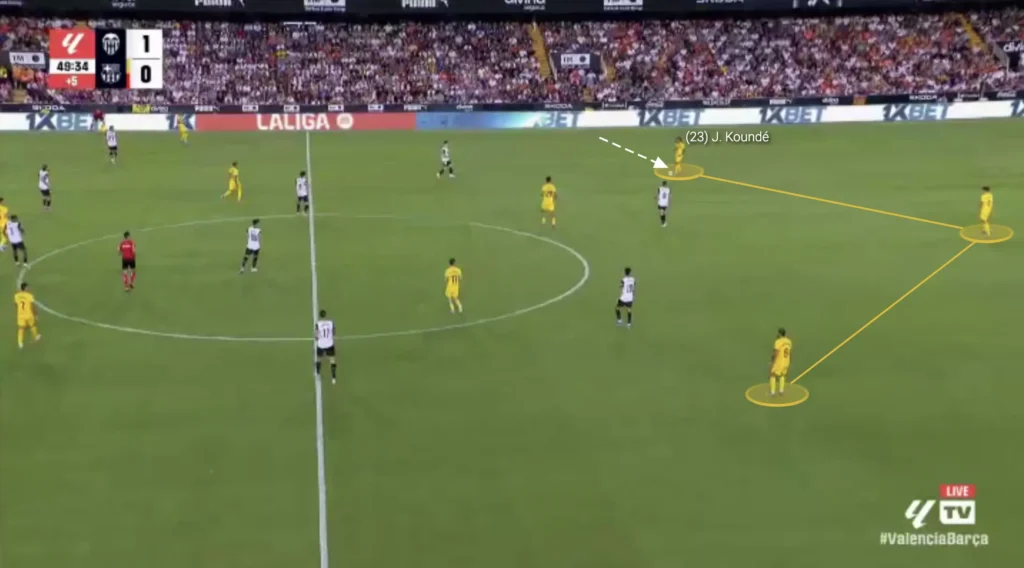

This creates a 1-3-4-3 formation. The 1-3-4-3 formation allows for a strong presence in the midfield, which helps in controlling the game and dictating the tempo. The three central defenders provide a solid foundation for recycling possession, while the four central midfielders can effectively link play between defense and attack. The striker and wingbacks, stretch the opposition’s defense, creating space and overloads in key areas.
An important aspect of Flick’s build-up is fluidity. The team often adopts a dynamic approach, shifting between formations to create numerical advantages and exploit spaces. Flick emphasizes versatility, with players interchanging positions seamlessly to maintain possession and disrupt the opposition’s defensive structure. The four central midfielders are especially fluid and can be positioned in either a box or a diamond.


Additionally, Kounde will sometimes invert into the midfield, next to the number-six, instead of coming into the backline. When Kounde inverts into the midfield, the opposition winger usually follows to cover the run, which opens the passing lane from the center-back to the winger. The center-back can play the ball to the winger, who can attack the opposition fullback and combine with the attacking midfielder to create a 2v1 situation.

Numerical Advantage in the midfield
Usually, Barcelona will have only one player on each wing and the rest in the center during the high build-up.

Having only two players out wide and the rest in the middle creates more options in the center and less space between the players. Flick likes this because he prioritizes playing through the middle. He needs one player out wide to pull the opposition apart while the rest create numerical advantages in the midfield areas. When a team outnumbers the opposition in the midfield, it can more easily retain the ball, exploit spaces, and progress the ball through the center. This advantage forces the opposing team to chase the game, which can lead to defensive errors and create opportunities for breaking down their defense.
Another purpose for keeping many players in the middle is to shorten the distance between them. This shortens the length of the passes, which naturally shortens the time between passes. This means the opposition players will have less time to push up and press, giving the Barcelona players more time and control.
Rest-Defence
Hansi Flick also wants many players close to the center to create a good rest-defence structure. Rest-defence is crucial for maintaining balance and preventing counterattacks when the team is in possession. Having many players in the middle builds good conditions in defensive transitions, allowing more players to counterpress when losing the ball. The defenders and holding midfielders form the core of the rest-defence, as they are well-positioned to deal with any potential loss of the ball. When losing possession, the four or five Barcelona players closest will immediately jump on the opposition player with the ball and close the distance to cut off any passing lanes. This approach disrupts the opponent’s transition from defense to attack, forcing errors and creating opportunities to regain control of the ball.


Counterpressing like this keeps Barcelona on the front foot, allowing them to dominate possession and create more scoring opportunities.
High Backline (Off)
Another massive aspect of Hansi Flick’s high possession build-up is to have the defenders high up. This helps in the counterpress because they get closer to the center. Having more players close to the center who can win the ball back makes it difficult for the opposition to do anything when they win possession. Furthermore, the high backline shortens the distance between players, shortening the time and length of the passes and preventing the opposition from pushing up their defense.

Finding the Pockets
Hansi Flick’s players always try to find the attacking midfielders in the pockets. These “pockets” refer to the spaces between the opposition’s defensive and midfield lines, where the attacking midfielders can receive the ball in more advanced positions. By positioning themselves intelligently in these pockets, the attacking midfielders can turn quickly and face the opposition’s goal, creating opportunities for through balls, driving runs, or direct shots. This positioning forces the opposition to make difficult decisions. If an opposition defender steps up and closes down the attacking midfielder, he potentially leaves space behind. If he stays back, he allows the midfielder time on the ball. The Barcelona defenders and midfielders will look for straight passes, breaking the opposition lines and finding the attacking midfielders who can turn and drive at the defense.

FC Barcelona will also use third-man combinations involving the striker to find players in these spaces. A defender can play a straight pass to the striker, who can find an attacking midfielder in the pocket with a simple one-touch pass.


Finding these pockets is crucial for maintaining fluidity in attack and ensuring that the team can progress the ball effectively through the middle of the pitch.
Runs in Behind
A new dimension that Hansi Flick has added to Barca’s build-up is their threat in behind. With rapid wingers like Lamine Yamal, Raphinha, and Ferrán Torres, FC Barcelona have started to be way more direct than they traditionally have been. Their wingers constantly make runs in behind when the defenders or midfielders have the ball, leading to many goalscoring opportunities from dangerous through-balls.


This constant threat also prevents the opposition from playing with a high backline and closing the space between the lines. Instead, they have to drop the backline and protect the space in behind. This opens the space in front of the backline for the technical Barcelona midfielders to exploit.
Numerical Advantages Against the Opposition’s Defense
Another aspect of Barcelona’s high build-up is their ability to create numerical advantages against the opposition’s defensive line. When they play with a front five, the forward line naturally becomes numerically superior against a back four, which they are great at taking advantage of.

Flick’s players mainly exploit this by creating 2v1 situations against the opposition fullback. When the defending team is positioned on one side, the weak-side fullback becomes vulnerable to the long switch of play due to the 1v2 against Barca’s winger and attacking midfielder. The attacking midfielder will make a run in behind, the fullback will follow that run, and the space for the winger out wide will be opened. Flick’s team often capitalizes on this by getting the ball to the winger and creating many opportunities from 2v1 situations on the wing and in the half-spaces.
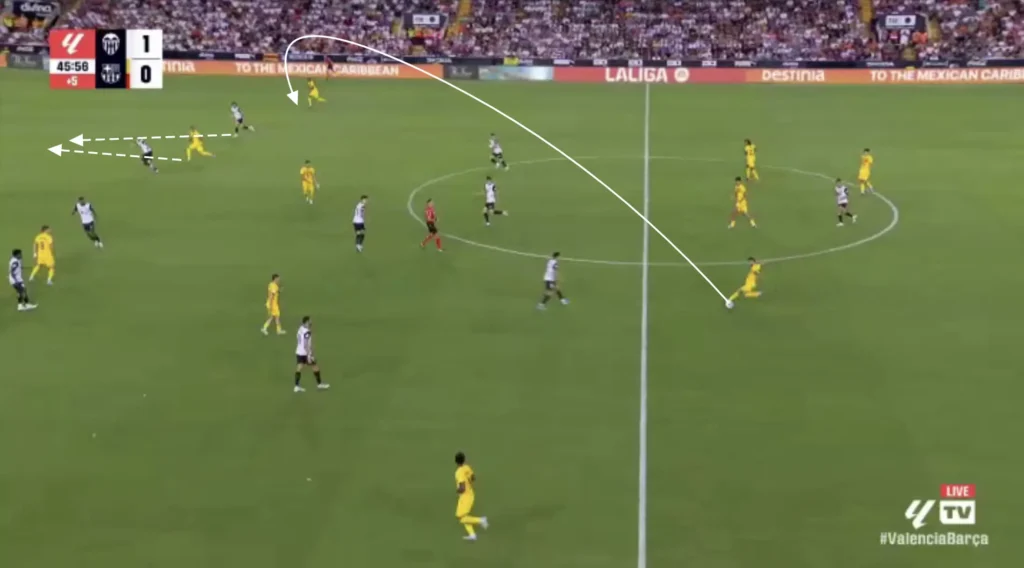
Attacking the Half-Space
Flick’s players usually look to create chances by attacking the space between the opposition center-back and fullback. They primarily do this from the wide areas with underlaps from the attacking midfielders. When the winger receives the ball out wide he will attract the opposition fullback. This opens the space between the fullback and the center-back, which allows the Barcelona attacking midfielder to make the underlapping run into this space. The ball can be played to the underlapping player, who can cross the ball into the box or attack his defender in a 1v1 situation.

The winger does not have to play the ball to the underlapping player. The run from the attacking midfielder will often drag away an opposition defensive midfielder, which opens the space inside. The winger can take the ball inside and shoot or find a pass to a free player in front of the backline.
Defending
High Press
Hansi Flick places much value on being aggressive without the ball. This shows in Barca’s high pressure. Flick usually wants his team to go man-to-man and intensely press the opposition. Each player is assigned a direct opponent to mark tightly, ensuring no easy passing options are available. This intense pressure forces the opposing team into hurried decisions, often resulting in turnovers in dangerous areas. FC Barcelona almost use their high press as an attacking threat, scoring many goals from winning the ball high up the pitch.

In a man-to-man system, it becomes crucial that the players know when to mark the opponent they are responsible for and when not to. If an opponent, for example, is very far from the ball, the Barcelona player marking him does not need to be as close to him. He can instead come in and help create numerical superiorities in the center, decreasing the risk of dangerous 1v1 situations.
The Barca fullbacks will be the furthest from the opposition player they are marking. In Flick’s man-to-man system, the fullbacks are responsible for the opposition fullbacks. He does not want the fullbacks to push all the way up because that would isolate the center-backs. Instead, he wants them to stay in the backline for as long as possible and only push up when the opposition fullbacks get the ball.

Here, the opposition goalkeeper is playing a long ball, making the opposition fullbacks irrelevant. Therefore, the Barcelona fullbacks drop back, putting them in a better position to win the second-ball. This results in Barca having a 7v5 numerical advantage around the first duel when the long ball comes, giving them good chances to win the second-ball.


How They Deal with the Opposition Fullbacks
The wingers are the ones who press the opposition center-backs in Barcelona’s high press. They need to close the passing lane to the opposition fullback by pressing the center-back from the outside, pushing them inside. If the center-back can play the easy pass out to the fullback, the Barca fullback will have to make the long run up the pitch for Barcelona to keep pressing. Therefore, the Barca winger should close the pass to the fullback while pressing the center-back, making it difficult for the opposition to progress the ball.


If the opposition reaches the fullback, for example through a long ball, Flick primarily wants the winger to track back and press the fullback if possible.
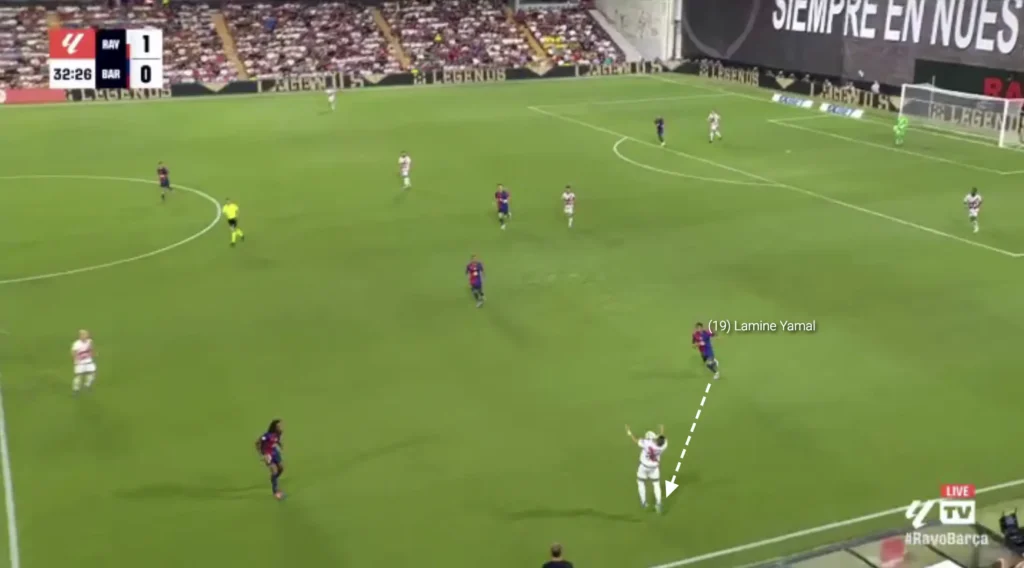
If the winger is too far away, the Barcelona fullback will have to push up and stop the opposition fullback from advancing the ball.
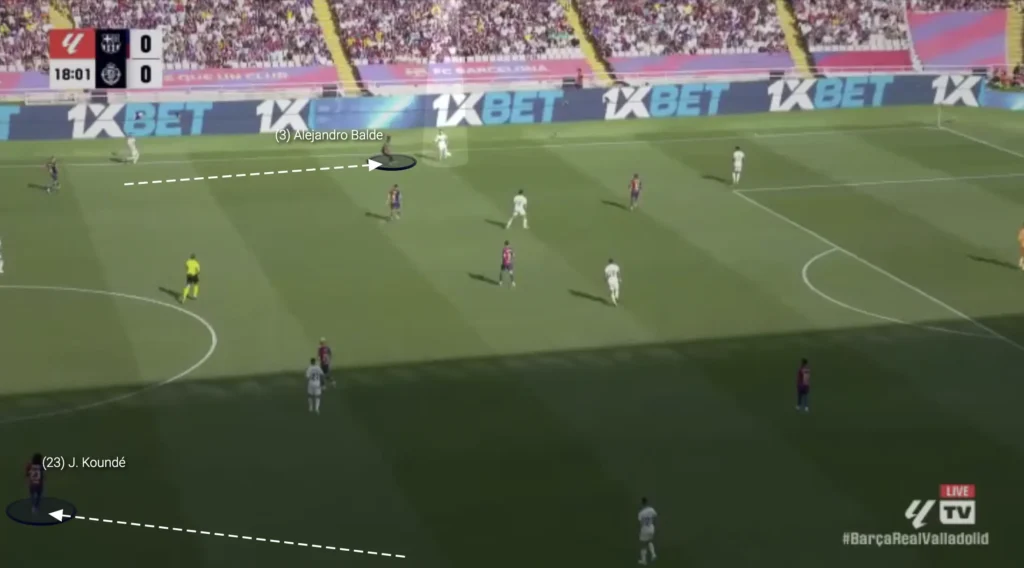
Low Press
Flick’s FC Barcelona uses a 1-4-3-3 formation in the low press. They look to set up in a mid-block, always trying to close the center and force the opposition out wide. Flick wants his team to stay compact without dropping too low, preferably closing the space between the midfield and backline.
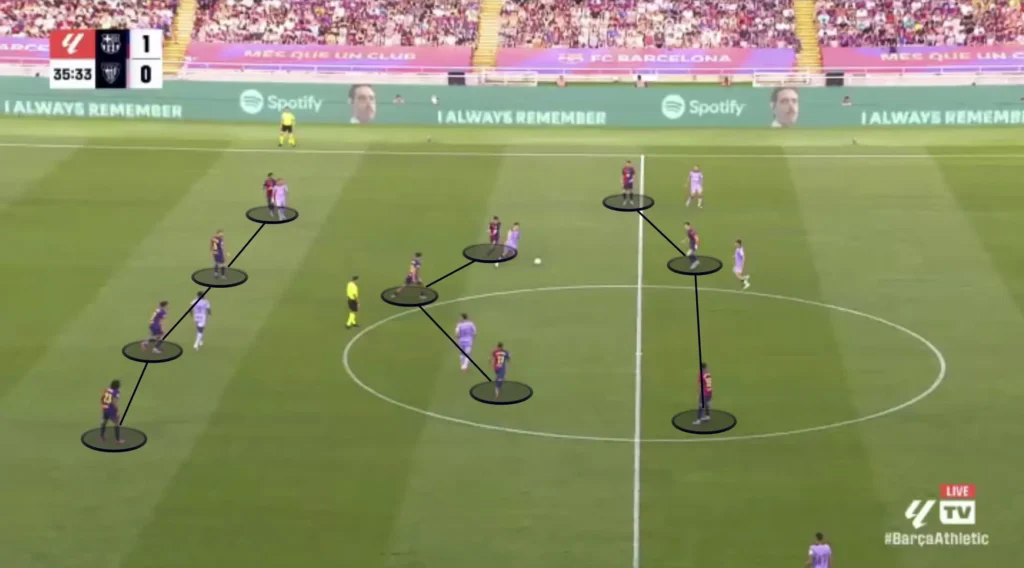
Defending in a 1-4-3-3 formation, with the wingers higher up, is centered around maintaining a compact forward line that forces the opposition to progress the ball on the flanks. The team should be a cohesive unit where the three midfielders play a crucial role in shielding the back four while also supporting the high press. The 1-4-3-3 is effective in closing down the center of the field, making it difficult for opponents to penetrate through the middle, and pushing them into less dangerous wide areas. The key to successful defending in this formation is the coordination between the midfield and defense, ensuring that gaps are minimized without dropping too deep.
Like in the high press, the wingers will press the opposition center-backs, trying to close the passing lane to the opposition fullback.


High Backline (Def)
One tool that helps to be compact is to play with a high backline, making the space to the midfield line as small as possible. Flick’s players do this and usually try to keep the highest line they can without leaving the space behind them too open. Defending with a high backline involves positioning the defensive line closer to the midfield, rather than near the goalkeeper. This tactic compresses the space available for the opposing team to operate, disrupting their build-up play and increasing the chances of winning the ball back quickly.

A high backline also allows defenders to support the midfield more effectively, creating numerical superiority in central areas and facilitating quicker transitions from defense to attack. However, it requires defenders with good pace and positional awareness to deal with long balls and prevent opposing attackers from exploiting the space behind. This approach demands constant communication and coordination among the backline to maintain a cohesive and effective defensive structure.
Everyone must be in the same line when defending with a high backline to maintain an effective offside trap, ensure cohesive coverage, and reduce gaps that attackers can exploit. A well-aligned defensive line makes it easier to catch opposing forwards offside, preventing them from receiving the ball in dangerous positions.
Squeezing the Pitch
Hansi Flick always wants his team to squeeze the pitch when defending. This means constantly pushing the team up as much as possible. Every time the opponent plays a slow, sideways pass or a back pass, Barca’s first line of pressure pushes up, with the rest of the team following to stay compact. When the next pass comes, they push up even more, forcing the opponent back even more. They do this because it pushes the opponent further away from the Barcelona goal, making it harder to create chances.

Final Thoughts
In conclusion, this tactical analysis of Hansi Flick’s approach to FC Barcelona highlights the innovative and meticulous strategies that define his managerial style. Flick’s ability to blend disciplined defensive structures with fluid attacking movements has brought a new dimension to Barcelona’s game. His focus on quick transitions, high pressing, and intelligent positioning reflects a deep understanding of the club’s footballing philosophy while also introducing fresh tactical ideas.
As Barcelona continues to adapt under Flick’s leadership, the tactical adjustments and innovations explored in this analysis will be key to their future success. The combination of Flick’s tactical understanding and Barcelona’s rich footballing tradition creates a promising outlook for the team, signaling a new era of strategic brilliance at the club.
